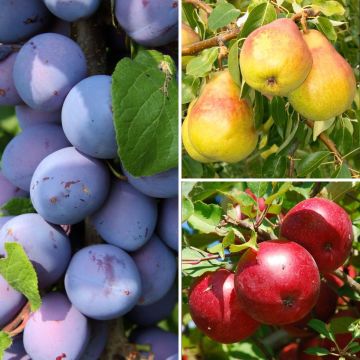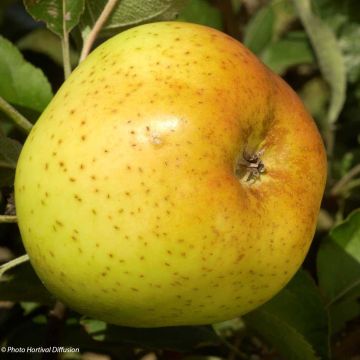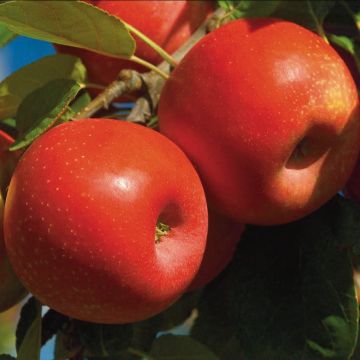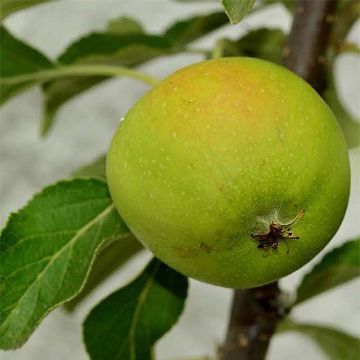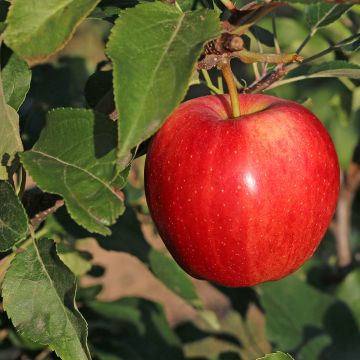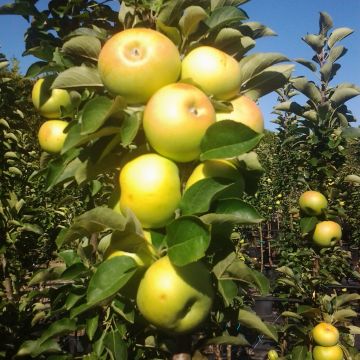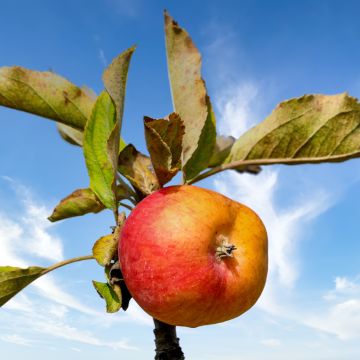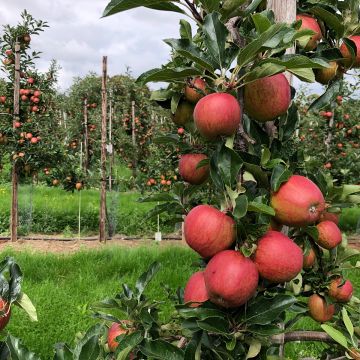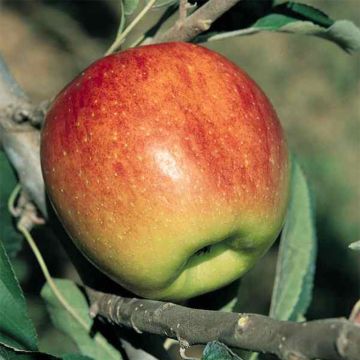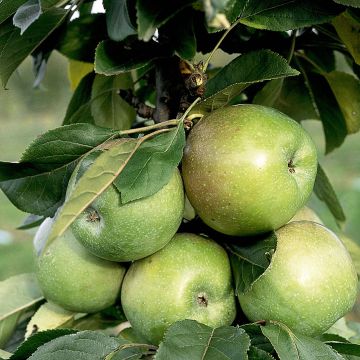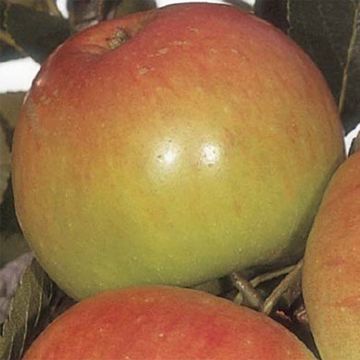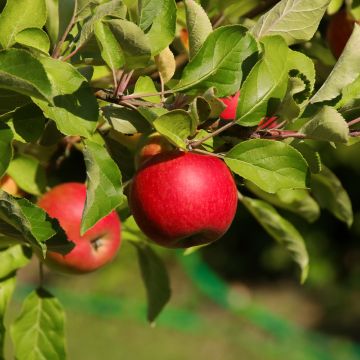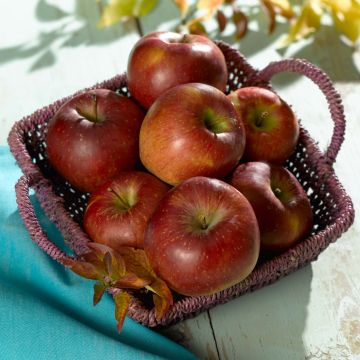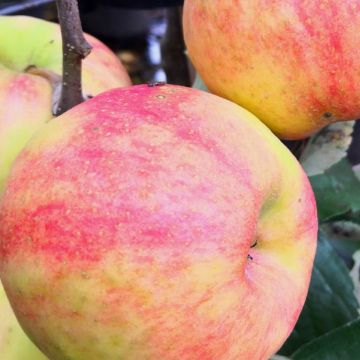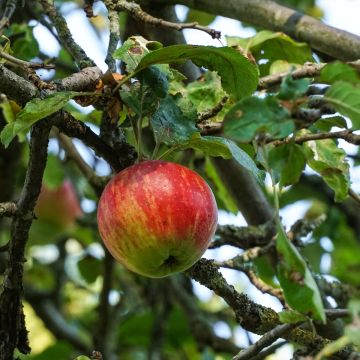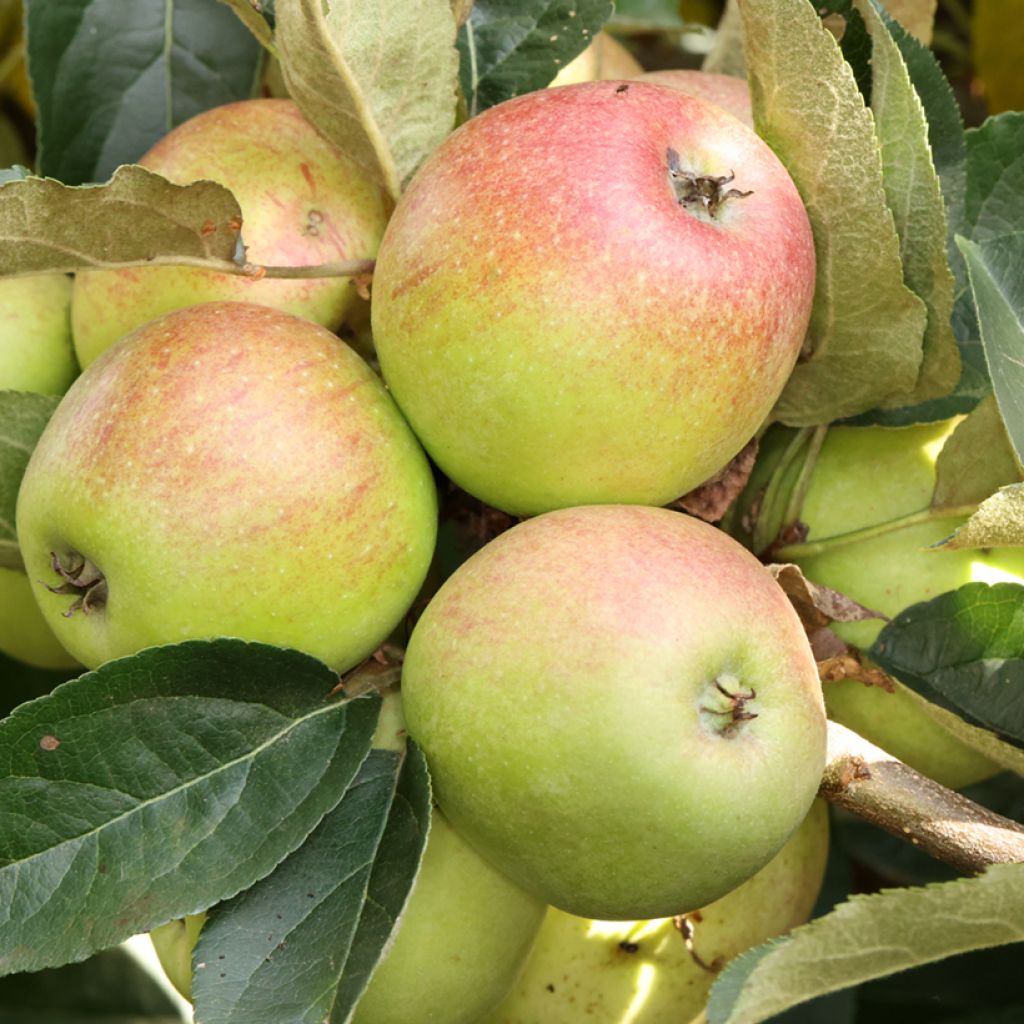

Apple Tree Grochówka - Malus domestica
Apple Tree Grochówka - Malus domestica
Malus domestica Grochówka
Apple, Domestic apple
Why not try an alternative variety in stock?
View all →This plant carries a 6 months recovery warranty
More information
We guarantee the quality of our plants for a full growing cycle, and will replace at our expense any plant that fails to recover under normal climatic and planting conditions.
Oversize package: home delivery by special carrier from €6.90 per order..
Express home delivery from €8.90.
Description
The 'Grochówka' Apple Tree is a historic variety, resistant to powdery mildew and apple scab. This variety is also very frost-resistant and is therefore often cultivated in Central Europe, such as in Poland. However, it is not self-fertile and therefore requires the presence of a pollinator to produce fruit. The apples are medium-sized, with a yellow-green colour marked with red, and have a fairly firm flesh. They are tart, even slightly sour at first, but become sweeter when stored for a long time. They are suitable for making preserves, juice, and desserts.
The Apple Tree (Malus) is one of the members of the large Rose family, which includes more than 5000 wild species (Potentilla, Burnet...), ornamental plants (Amelanchier, Cotoneaster, Roses of course), as well as most of our temperate climate fruit trees (Pear trees, Apricot trees...). The Malus genus includes approximately thirty-five species of deciduous trees, both ornamental and fruit-bearing. The Malus domestica, or Common Apple Tree, is the most important fruit-bearing species, whose ancestor is native to Central Asia. It is undoubtedly the most cultivated fruit tree in Northern Europe, with about 20,000 varieties recorded.
'Grochówka' is an old German variety from the 18th century, initially known as 'Grosser Rheinischer Bohnapfel' and also by many other names depending on the country ('Gros Bohn' in France, where it was imported in 1868 by a certain Leroy). This apple tree forms a conical crown that gradually widens and reaches approximately 4 to 5 m in height and 3 to 4 m in width. Narrower when young, its crown, formed by branches covered with dark green leaves, widens with age. This variety is well-suited for organic cultivation as it is naturally resistant to apple scab and powdery mildew. It is also perfect for cold climates as it is extremely frost-resistant. In addition, its flowering is late, the white-pink flowers, slightly fragrant, often only appear in May, which is a definite advantage compared to late spring frosts (which are fatal to production at temperatures below -2° to -3°C). However, as for disadvantages, it is a triploid variety that produces poor quality pollen, making it unable to pollinate other apple varieties. Self-sterile, it needs to be pollinated by other varieties, such as Reinette ananas or Ontario. It then produces medium-sized fruits, 6 to 7 cm in diameter, spherical to oval, with a yellow-green skin and red on the sunny side. Like the flowering, fruiting is logically also late, mainly in October. The fruits have a hard white-yellow flesh, which makes them resistant to mechanical stress and easy to transport. They are widely used in professional production for making preserves. For amateur use, it is recommended to wait until January or February before consuming these apples, as they are tart and slightly sour when harvested. During this storage period, they develop a sweeter and more aromatic flavour than initially. Juicy, they also have an above-average vitamin C content. Under good conditions (cool, healthy place, protected from light, at a temperature around 8 to 10 °C), these apples can be stored until June. You can consume them as juice, dessert, or even as a sliced fruit when the sugar content is sufficiently increased. It should be noted that this variety alternates, meaning that a lean year generally follows a year of high production, as the plant replenishes its reserves in a way. It is therefore recommended to thin out, in other words, remove part of the overly abundant production to try to have a better harvest the following year.
The 'Grochówka' Apple Tree is a variety that has as many advantages as disadvantages, and should therefore be chosen with full knowledge. Well-suited for cold climates, you can plant it alongside other resistant species to create a robust orchard. The Mirabelle de Nancy will be perfect for this role, with its delicious yellow plums in August. In the Pear Tree genus, many varieties are just as hardy and will delight you with their tasty fruits. Unjustly forgotten, the Medlar (Mespilus germanica) will allow you to diversify your harvests with this large shrub, whose white blossoms have a charm of their own.
Report an error about the product description
Plant habit
Fruit
Flowering
Foliage
Botanical data
Malus
domestica
Grochówka
Rosaceae
Apple, Domestic apple
Malus domestica 'Gros Bohn'
Cultivar or hybrid
Other Apple trees
Planting and care
Choose a sunny location for your 'Grochówka' Apple Tree. The soil can be slightly alkaline or acidic, but without excess. Dig a wide planting hole at least three times the size of the root ball. Add organic matter (potting soil, compost...) and a slow-release fertiliser like bonemeal at the same time. Do not bury the graft collar. Stake if necessary. For apple trees planted in isolation and in open areas, it can be beneficial to stake them with a guy-wire system: plant 3 stakes in a triangle 50 cm away from the trunk, connect them with pieces of wood. Protect the bark with a piece of rubber, for example, and attach the stakes to the trunk with wire. Initially, water abundantly, even in winter, even if it rains. Fruit trees are ideally planted between October and March, outside of the freezing period. Container-grown plants can be planted all year round, except during periods of high heat or frost.
In winter, at the base of the tree and slightly incorporated into the soil surface, you can add a small handful of wood ash, rich in potash, to improve fruiting. Apple trees can be susceptible to various diseases and pests. To limit risks, space the trees sufficiently, install multi-species hedges, birdhouses, or insect hotels to attract beneficial insects. In summary: prioritise diversity. This variety is resistant to scab (brown spots on leaves) and powdery mildew (white powdery coating on leaves), making it suitable for organic cultivation. As for pests, the codling moth (or fruit worm) is a small caterpillar that burrows inside the fruit. To address this, it is preferable to take preventive action by promoting the presence of tits and bats through the installation of nest boxes. In case of aphid infestation, spray a solution based on black soap.
During the harvest in October, keep in mind that for good storage, it is advisable to place the apple with its stem pointing downwards, in trays or crates. Choose a preferably completely dark, dry, and cool place, but frost-free. Under these conditions, 'Grochówka' apples can be stored until June.
Planting period
Intended location
Care
This item has not been reviewed yet - be the first to leave a review about it.
Haven't found what you were looking for?
Hardiness is the lowest winter temperature a plant can endure without suffering serious damage or even dying. However, hardiness is affected by location (a sheltered area, such as a patio), protection (winter cover) and soil type (hardiness is improved by well-drained soil).

Photo Sharing Terms & Conditions
In order to encourage gardeners to interact and share their experiences, Promesse de fleurs offers various media enabling content to be uploaded onto its Site - in particular via the ‘Photo sharing’ module.
The User agrees to refrain from:
- Posting any content that is illegal, prejudicial, insulting, racist, inciteful to hatred, revisionist, contrary to public decency, that infringes on privacy or on the privacy rights of third parties, in particular the publicity rights of persons and goods, intellectual property rights, or the right to privacy.
- Submitting content on behalf of a third party;
- Impersonate the identity of a third party and/or publish any personal information about a third party;
In general, the User undertakes to refrain from any unethical behaviour.
All Content (in particular text, comments, files, images, photos, videos, creative works, etc.), which may be subject to property or intellectual property rights, image or other private rights, shall remain the property of the User, subject to the limited rights granted by the terms of the licence granted by Promesse de fleurs as stated below. Users are at liberty to publish or not to publish such Content on the Site, notably via the ‘Photo Sharing’ facility, and accept that this Content shall be made public and freely accessible, notably on the Internet.
Users further acknowledge, undertake to have ,and guarantee that they hold all necessary rights and permissions to publish such material on the Site, in particular with regard to the legislation in force pertaining to any privacy, property, intellectual property, image, or contractual rights, or rights of any other nature. By publishing such Content on the Site, Users acknowledge accepting full liability as publishers of the Content within the meaning of the law, and grant Promesse de fleurs, free of charge, an inclusive, worldwide licence for the said Content for the entire duration of its publication, including all reproduction, representation, up/downloading, displaying, performing, transmission, and storage rights.
Users also grant permission for their name to be linked to the Content and accept that this link may not always be made available.
By engaging in posting material, Users consent to their Content becoming automatically accessible on the Internet, in particular on other sites and/or blogs and/or web pages of the Promesse de fleurs site, including in particular social pages and the Promesse de fleurs catalogue.
Users may secure the removal of entrusted content free of charge by issuing a simple request via our contact form.
The flowering period indicated on our website applies to countries and regions located in USDA zone 8 (France, the United Kingdom, Ireland, the Netherlands, etc.)
It will vary according to where you live:
- In zones 9 to 10 (Italy, Spain, Greece, etc.), flowering will occur about 2 to 4 weeks earlier.
- In zones 6 to 7 (Germany, Poland, Slovenia, and lower mountainous regions), flowering will be delayed by 2 to 3 weeks.
- In zone 5 (Central Europe, Scandinavia), blooming will be delayed by 3 to 5 weeks.
In temperate climates, pruning of spring-flowering shrubs (forsythia, spireas, etc.) should be done just after flowering.
Pruning of summer-flowering shrubs (Indian Lilac, Perovskia, etc.) can be done in winter or spring.
In cold regions as well as with frost-sensitive plants, avoid pruning too early when severe frosts may still occur.
The planting period indicated on our website applies to countries and regions located in USDA zone 8 (France, United Kingdom, Ireland, Netherlands).
It will vary according to where you live:
- In Mediterranean zones (Marseille, Madrid, Milan, etc.), autumn and winter are the best planting periods.
- In continental zones (Strasbourg, Munich, Vienna, etc.), delay planting by 2 to 3 weeks in spring and bring it forward by 2 to 4 weeks in autumn.
- In mountainous regions (the Alps, Pyrenees, Carpathians, etc.), it is best to plant in late spring (May-June) or late summer (August-September).
The harvesting period indicated on our website applies to countries and regions in USDA zone 8 (France, England, Ireland, the Netherlands).
In colder areas (Scandinavia, Poland, Austria...) fruit and vegetable harvests are likely to be delayed by 3-4 weeks.
In warmer areas (Italy, Spain, Greece, etc.), harvesting will probably take place earlier, depending on weather conditions.
The sowing periods indicated on our website apply to countries and regions within USDA Zone 8 (France, UK, Ireland, Netherlands).
In colder areas (Scandinavia, Poland, Austria...), delay any outdoor sowing by 3-4 weeks, or sow under glass.
In warmer climes (Italy, Spain, Greece, etc.), bring outdoor sowing forward by a few weeks.


































